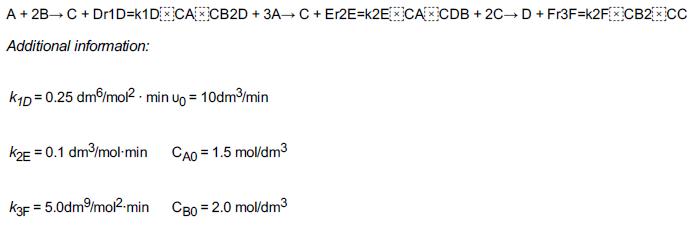In this problem, the complex reactions described below will first be carried out in the liquid phase
Question:
In this problem, the complex reactions described below will first be carried out in the liquid phase (parts (a) through (d)) and then in the gas phase (parts (e) through (g)). One need not solve the liquid phase to solve the gas-phase problems. The following reactions are carried out isothermally.
a. Consider the reactions to be liquid phase and plot the species concentrations and the conversion of A as a function of the distance (i.e., volume) down a 50-dm3 PFR. Note any maxima.
b. Consider the reactions to be liquid phase and determine the effluent concentrations and conversion from a 50-dm3 CSTR.
c. Plot and analyze the species concentrations and the conversion of A as a function of time when the reaction is carried out in a semibatch reactor initially containing 40 dm3 of liquid. Consider two cases: (1) A is fed to B, and (2) B is fed to A. What differences do you observe for these two cases? Describe what you find.
d. Vary the ratio of B to A (1 e. Rework (a) for the case when the reaction is a gas-phase reaction. We will keep the constants the same so you won’t have to make too many changes in your Polymath program, but we will make υ0 = 100 dm3/min, CT0 = 0.4 mol/dm3, V = 500 dm3, and an equimolar feed of A and B. Plot the molar flow rates and SC/D and SE/F down a PFR. Describe what you find.
f. Repeat (e) when D diffuses out through the sides of a membrane reactor where the mass transfer coefficient, kCD, can be varied between 0.1 and 10 min–1. What
trends do you find?
g. Repeat (e) when B is fed through the sides of a membrane reactor. Describe what you find.
Step by Step Answer:






